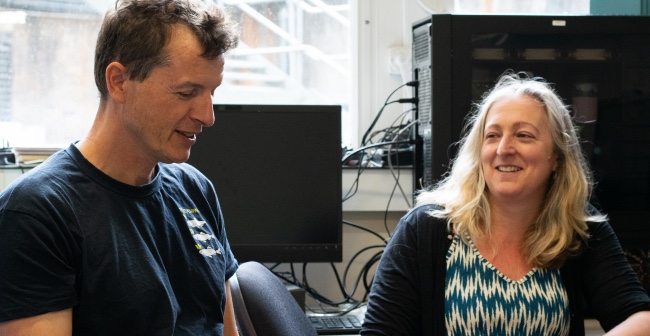Although Isambard-AI has been built by Bristol Centre for Supercomputing, based at University of Bristol, researchers from across the UK can apply to use Isambard – opening up and democratising the power of AI.
Our university colleagues are already using Isambard-AI for pioneering research projects. Below, two of these colleagues reveal their research project, how Isambard-AI is underpinning it and what the future might hold.
Dr. Jon Lees and Dr. Danielle Paul – understanding the cell to understand diseases

My name is Dr. Jon Lees and I'm a lecturer in Bioinformatics. I've been collaborating with Danielle and lots of other experimentalist groups.
I'm Dr. Danielle Paul. I am a Senior Research Fellow, funded by the British Heart Foundation.
Tell us a bit about your project
Jon: We’ve been working together, with lots of other researchers, to understand how human cells works and are wired - in terms of their network of protein interactions.
Danielle: Proteins are the building blocks of the cell and have specific roles and functions.
Jon: They essentially link up together to do certain jobs and when that goes wrong, you get certain diseases. We’ve been looking at Alzheimer's, heart disease and cancer to understand the key proteins that cause them.
Before we can understand diseases, or how to fix them, we need to work out how the cell actually works. If you looked at a car engine, for example, you can't really fix cars unless you understand the mechanics and how the bits work together.
How are you using Isambard-AI?
Danielle: We can use Isambard-AI to predict protein structures and study changes that occur when you have a [disease causing] mutation.
Jon: Isambard-AI is kind of the computer of your dreams. It allows us to scale everything up and just try out new things that you couldn't before. We can construct more of the whole cell, not just bits, to properly understand it.
Danielle: The scale of what we can actually look at and what we can model in one go is much bigger. We can see larger protein complexes and more cell interactions with Isambard-AI.
Jon: It would take like 50 years on my own computer at home. These models are so big and, that's why they're so good, but we needed Isambard-AI's power – without it, we wouldn’t be doing the project.
Next steps
Jon: We're looking at translating it to therapeutics (the treatment of diseases). Developing peptide inhibitor treatments, like Ozempic (for weight loss and diabetes), but for various other diseases. Also, how viruses interact with the human genome – which might be good for future Pandemic preparedness.
Danielle: I’m focusing on an inherited heart disease called Hypertrophic cardiomyopathy, which is the leading cause of sudden adult death in the young. There's a new class of drugs that reached the clinic last year which has been a real game changer. Eventually, I would love to have targets for therapeutics directed at other proteins central to the disease.
Jon: Isambard-AI has given us lots of interesting new avenues of research and we’re building a network of researchers across Bristol... were very excited for the future possibilities Isambard-AI will open up for health and wellbeing.
The Isambard-AI system has a great user experience. The team at the Bristol Centre for supercomputing (BRICS), who built and manage Isambard-AI, have done a terrific job and managed to deliver this amazing project really fast.
